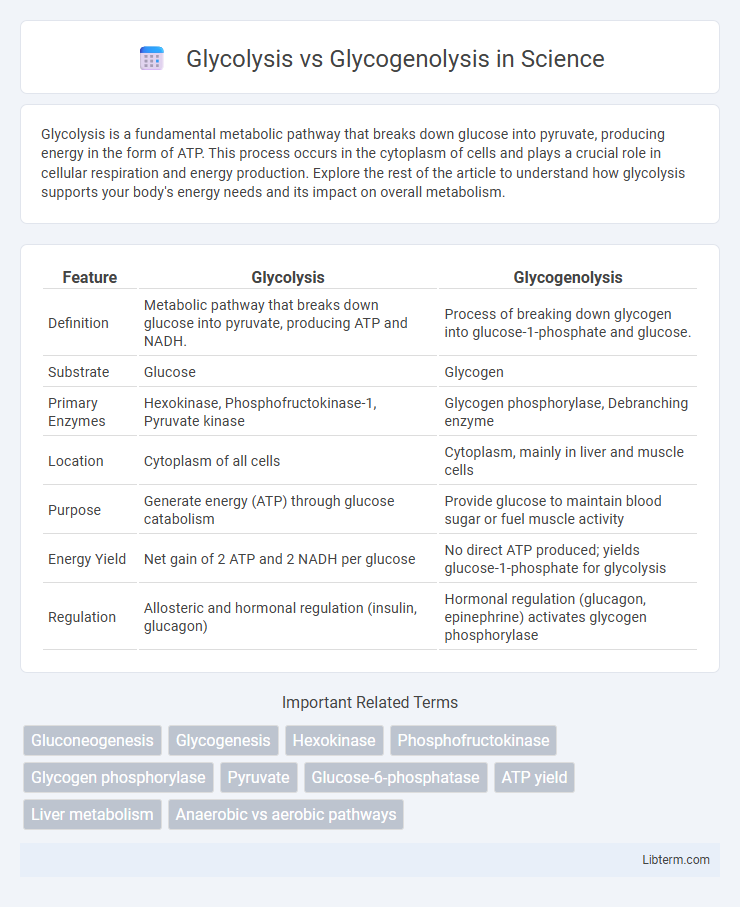Glycolysis is a fundamental metabolic pathway that breaks down glucose into pyruvate, producing energy in the form of ATP. This process occurs in the cytoplasm of cells and plays a crucial role in cellular respiration and energy production. Explore the rest of the article to understand how glycolysis supports your body's energy needs and its impact on overall metabolism.
Table of Comparison
| Feature | Glycolysis | Glycogenolysis |
|---|---|---|
| Definition | Metabolic pathway that breaks down glucose into pyruvate, producing ATP and NADH. | Process of breaking down glycogen into glucose-1-phosphate and glucose. |
| Substrate | Glucose | Glycogen |
| Primary Enzymes | Hexokinase, Phosphofructokinase-1, Pyruvate kinase | Glycogen phosphorylase, Debranching enzyme |
| Location | Cytoplasm of all cells | Cytoplasm, mainly in liver and muscle cells |
| Purpose | Generate energy (ATP) through glucose catabolism | Provide glucose to maintain blood sugar or fuel muscle activity |
| Energy Yield | Net gain of 2 ATP and 2 NADH per glucose | No direct ATP produced; yields glucose-1-phosphate for glycolysis |
| Regulation | Allosteric and hormonal regulation (insulin, glucagon) | Hormonal regulation (glucagon, epinephrine) activates glycogen phosphorylase |
Introduction to Glycolysis and Glycogenolysis
Glycolysis is a metabolic pathway that breaks down glucose into pyruvate, producing ATP and NADH as energy sources for cellular functions. Glycogenolysis involves the enzymatic breakdown of glycogen into glucose-1-phosphate, supplying glucose during fasting or increased energy demand. Both processes play critical roles in maintaining blood glucose levels and energy homeostasis in muscle and liver tissues.
Key Definitions and Overview
Glycolysis is the metabolic pathway that breaks down glucose into pyruvate, producing ATP and NADH as energy sources for cellular activities. Glycogenolysis involves the enzymatic breakdown of glycogen into glucose-1-phosphate, which enters glycolysis or gluconeogenesis to maintain blood glucose levels. Both processes are crucial for energy regulation, with glycolysis providing immediate ATP from glucose and glycogenolysis mobilizing stored energy during fasting or increased energy demand.
Cellular Location of Each Pathway
Glycolysis occurs predominantly in the cytoplasm of cells, where glucose is enzymatically broken down into pyruvate to produce ATP and NADH. Glycogenolysis also takes place in the cytoplasm, involving the enzymatic degradation of glycogen into glucose-1-phosphate, which then enters glycolysis or other metabolic pathways. Both pathways are crucial for cellular energy metabolism, utilizing cytosolic enzymes to regulate glucose availability and ATP production efficiently.
Main Functions and Biological Importance
Glycolysis is the metabolic pathway that breaks down glucose into pyruvate, generating ATP and NADH to provide immediate cellular energy. Glycogenolysis involves the enzymatic breakdown of glycogen into glucose-1-phosphate, supplying glucose during periods of fasting or increased energy demand. Both processes are crucial for maintaining blood glucose homeostasis and supporting cellular metabolism in tissues like muscle and liver.
Enzymes Involved in Glycolysis vs Glycogenolysis
Glycolysis involves key enzymes such as hexokinase, phosphofructokinase-1, and pyruvate kinase that catalyze the sequential breakdown of glucose into pyruvate, generating ATP and NADH. Glycogenolysis is primarily driven by glycogen phosphorylase, which cleaves glucose units from glycogen, and debranching enzyme that remodels glycogen branches for efficient glucose release. The distinct enzymatic activities in glycolysis and glycogenolysis reflect their roles in glucose catabolism and mobilization, respectively.
Step-by-Step Pathway Comparison
Glycolysis breaks down glucose into two molecules of pyruvate through a ten-step enzymatic process involving key enzymes such as hexokinase, phosphofructokinase, and pyruvate kinase. Glycogenolysis involves the sequential removal of glucose-1-phosphate units from glycogen by glycogen phosphorylase, followed by conversion to glucose-6-phosphate via phosphoglucomutase before entering glycolysis or releasing free glucose. Both pathways intersect at glucose-6-phosphate but differ fundamentally in substrate origin and enzymatic steps converting stored glycogen versus extracellular glucose into energy-yielding metabolites.
Regulation and Control Mechanisms
Glycolysis is primarily regulated by key enzymes including hexokinase, phosphofructokinase-1 (PFK-1), and pyruvate kinase, which respond to cellular energy levels such as ATP and AMP concentrations to modulate pathway flux. Glycogenolysis regulation centers on glycogen phosphorylase activity, controlled by hormonal signals like glucagon and adrenaline via cyclic AMP-dependent phosphorylation, facilitating rapid glucose release in response to energy demands. Both pathways exhibit intricate feedback mechanisms ensuring metabolic homeostasis by adjusting glucose utilization and mobilization according to cellular and hormonal signals.
Energy Yield and Metabolic Outcomes
Glycolysis generates a net gain of 2 ATP molecules and 2 NADH per glucose molecule through the breakdown of glucose into pyruvate, serving as a key pathway for cellular energy production under aerobic and anaerobic conditions. Glycogenolysis mobilizes stored glycogen into glucose-1-phosphate, which enters glycolysis, enhancing energy availability by rapidly supplying substrate for ATP synthesis during high energy demand. The metabolic outcome of glycolysis includes ATP production and pyruvate formation for further oxidation, whereas glycogenolysis primarily supports energy homeostasis by maintaining glucose levels for sustained ATP generation in muscle and liver tissues.
Physiological and Clinical Significance
Glycolysis is a critical metabolic pathway that converts glucose into pyruvate, generating ATP for immediate cellular energy needs, essential in tissues with high energy demands such as muscles and the brain. Glycogenolysis involves the breakdown of glycogen stores into glucose-1-phosphate, serving as a vital mechanism for maintaining blood glucose levels during fasting or intense physical activity. Clinically, impaired glycolysis can result in energy deficits and lactic acidosis, while dysfunctional glycogenolysis is linked to glycogen storage diseases and hypoglycemia, highlighting their significance in metabolic homeostasis and disease management.
Summary Table: Glycolysis vs Glycogenolysis
Glycolysis is the metabolic pathway that converts glucose into pyruvate, generating ATP and NADH, while glycogenolysis is the process of breaking down glycogen into glucose-1-phosphate to supply energy during fasting or exercise. Key enzymes include hexokinase and phosphofructokinase for glycolysis, versus glycogen phosphorylase for glycogenolysis. Glycolysis occurs in the cytoplasm of all cells under anaerobic or aerobic conditions, whereas glycogenolysis primarily takes place in liver and muscle tissues to maintain blood glucose levels.
Glycolysis Infographic

 libterm.com
libterm.com